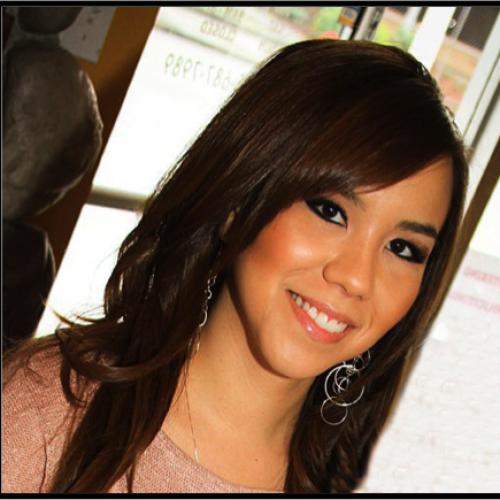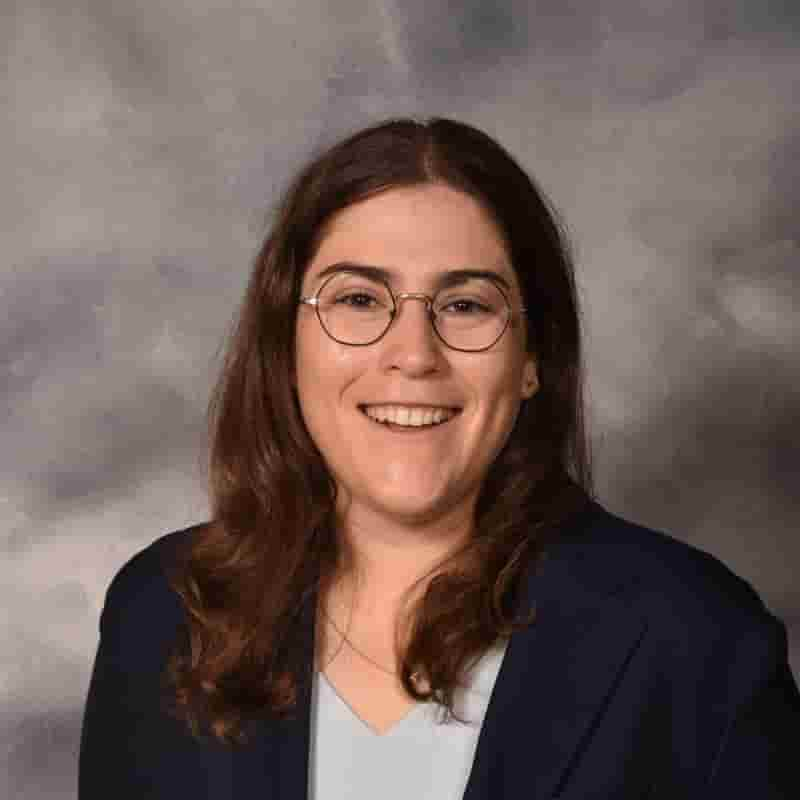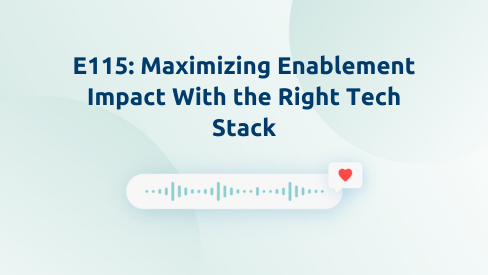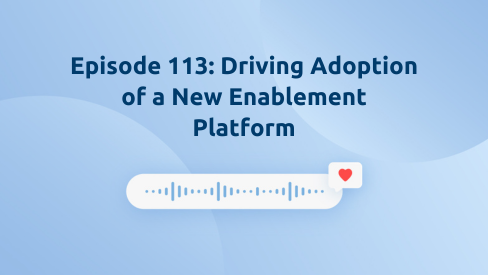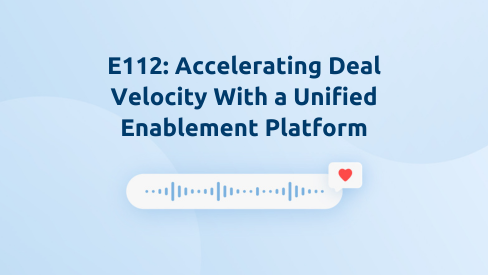According to the State of Sales Enablement Report from 2024, teams that utilize data-driven training are 36% more likely to decrease ramp time. So how can you ensure your training programs are maximizing sales readiness?
Shawnna Sumaoang: Hi, and welcome to the Win Win Podcast. I am your host, Shawnna Sumaoang. Join us as we dive into changing trends in the workplace and how to navigate them successfully.
Here to discuss this topic is Lizzy Goldstein, the sales enablement manager at Newsela, Inc. Thank you for joining us, Lizzy. I’d love for you to tell us about yourself, your background, and your role.
Lizzy Goldstein: Thank you for having me, Shawnna. My name is Lizzy Goldstein, I am the director of enablement at Newsela and II started my career in education. I was a ninth-grade ELA teacher and I transitioned into tech sales where I was on the new business end for two years. Then I joined Newsela almost six years ago as a customer success manager, working with the schools and school districts that purchase our product.
I moved to the enablement team about three years ago and have had a lot of success growing on this team, using both my education background and sales background to really help me navigate through this enablement experience.
SS: Amazing. You touched on this a little bit around your prior experience before going into enablement and how you have a background in education—which I have so much respect for those who have been in the teaching field. Thank you for all that you did in that role. I imagine that some of that actually carries over into enablement. How does your teaching experience influence your approach to your enablement strategy?
LG: I’m lucky at Newsela in that we are an education platform and so I work with a lot of former educators.
Two things that are really top of mind for me when I am creating new enablement materials is outcomes and engagement. That really comes from my teaching experience. Whenever, as a teacher, you start planning a unit you first look at what are the outcomes I want my students to be able to achieve at the end of this time.
You say, what do I want them to be able to do? And then everything you teach should be teaching to that outcome. If you want them to be able to identify verbs and nouns in a sentence, we make that our end goal and then we make sure that we teach verbs and nouns throughout the unit. We call that backwards planning where we start with what’s our goal and then what do we want to achieve, how are we going to get there?
The way to ensure that students are taking in what you’re teaching is engagement—it has to be interesting, it has to be engaging. Otherwise, it’s going right over—if you are just speaking at a group it’s really hard for that to penetrate and for that to really resonate with your learners. Once you know what the outcomes are, then we talk about how are we going to engage these learners and make sure that the material that we share is interesting and relevant to them.
SS: I love that approach. If we take a step back, tell us more about your enablement strategy at Newsela. What are some of the key go-to-market initiatives that you’re focused on supporting?
LG: Last year we purchased a company called Formative, which is also in the education space and that acquisition has taken a lot of our focus over the last year. We had to onboard the formative sales reps and CSMs to teach them about the Newsela product suite and also teach them our sales process.
Then, we had to look at our existing sales organization and teach them the new product that we had acquired. So, there was a lot of A to B and B to A kind of learning and we also had to discover what was our product strategy for these two unique products that also work pretty well together.
How can we ensure that our go to market team understands the value of the products individually and then also the value of the products when paired together? That’s been a large focus of mine over the past year. From an industry standpoint, the education space was really impacted by COVID, and districts are still really feeling that when planning for the 2024 to 2025 school year. Especially because ESSER funds, which are federal funds, were such a large part of funding for the last two years and that ESSER funding has run out.
A lot of districts are being much more picky when looking at their product suite than they ever were before because they are tens of millions of dollars in the hole compared to what they were in the previous term. So how do we educate our go-to-market team about this changing landscape? And then, continue to drive value and show our districts the value that Newsela brings to keep our product on their budget for the next year.
SS: That does sound like a lot of things that enablement is trying to help make sure you are steering for the organization. What role does your enablement platform, Highspot, play in helping you land your go-to-market initiatives?
LG: The word that comes to mind with Highspot for us is accountability. We consider Highspot our source of truth; every marketing collateral that we have for customers is in Highspot, a lot of our knowledge documents are in Highspot. When we talk about the changing landscape of the education field, we post podcasts. We want them to use the results about the education space, and articles about the education space in Highspot, and expect our go-to-market team to find those resources there.
We really want them to use Highspot as that internal Google search—if they have a question about Newsela, Formative, or education in general, they know that they can find the answers in Highspot. We use Highspot’s analytics to ensure that our go-to-market team is investing time in those new initiatives so we can track usage of resources that we send. Let’s say we publish a podcast about the changing landscape of education. We then look to see how long our go-to-market team, individuals we also created certification tracks for our go-to-market team and shared weekly reports with managers to broadcast how much time their team was investing and made it a little competitive. Always shouted out, “Great job, Elizabeth’s team for an average of eight hours this week in Highspot learning about the new Formative platforms.” So, we use the analytics to make sure that managers and individual contributors understand that we don’t just throw it in Highspot and not look at it again.
We are constantly checking in and making sure that everybody is using the resources that we spend time creating for them, and if they’re not, maybe there’s a problem with the resources, maybe they don’t actually hit the points that are necessary. Maybe we missed the mark. And so we need to know that so that we can then publish new pieces of material. So using that accountability and talking to managers, talking to individual contributors and saying, “Hey, I noticed you didn’t spend that much time listening to this podcast. Was it not helpful to you? Was it just something you didn’t have time for this week? Let me know so that we can then update our resources and make sure that they really do align to your goals.”
SS: I love that. Recently, your team had a huge training initiative and I believe you created north of 30 courses. Can you tell us more about this effort and how your team brought it to life using Highspot?
LG: Yeah, those 30 courses relate to our new acquisition. We had to create courses for our Newsela go-to-market team about the Formative platform, we had to create resources for the Formative team about the Newsela platform, and we had to create new resources for new products that allowed those two to work together. So, it was a lot of effort and a lot of talking to different SMEs across the organization. What was really important to us was to make sure that in six to nine months, there wasn’t really a difference between a Formative sales rep and a Newsela sales rep.
We wanted to make sure that the entire go-to-market organization had the same baseline level of knowledge for our entire product suite. We knew that a person who’s more comfortable selling Formative is going to continue to sell Formative and they’re not going to sell the Newsela product suite and vice versa. So we needed to make sure there was that baseline level of comfort.
We used Highspot to both educate and evaluate our sales reps. We built e-learning courses that allowed them to explore the new platforms. And then going back to that accountability, there was always an evaluation. We had formative evaluations throughout the courses and then summative evaluations at the end, to make sure that they weren’t just sitting in front of the screen without a chance to practice what they were learning. We gave them an opportunity and used our managers as reviewers to make sure that they knew where their sales reps were, they knew their comfort level, they could hear their pitches, and they could really get a sense for each one of their ICs where they were through this transition.
I think keeping the managers really involved was a big part of our success because, it made enablement feel like it wasn’t some black box, that they would just get these materials and nobody would know if It was looked at. They would record videos and not sure who was reviewing it.
There was really a relationship between them and their reviewer, and so I think the expectations were higher because they knew that their managers were involved. They knew that their managers really cared and that they were putting an effort into reviewing their work. So, I think that was a big part of our success was bringing in that management level.
SS: What are some of your other best practices? You talked in your intro about how important it is to really engage the learner. So what are some of your best practices for creating effective training programs for your sales teams?
LG: As much as I love hearing the sound of my own voice, I know that not everybody loves to hear the same person over and over again. We really try to make sure that with every enablement session, we’re bringing in different voices. We like to really vary who that is—we’ll have executive sponsorship, and we will get C-suites, and I think that really sets the tone in training sessions and to do introductions or to be a part of our videos. But then we also love to leverage our IC’s. They’re experts in the field.
They have great knowledge. They have great best practices. And so we love to invite IC’s to be a part of our trainings as well. And I think that really, people love to hear from their peers—they love to hype up their friends. That makes a huge difference for us when somebody gets on the screen and—we are a Google Meet organization—all the emojis pop up at the bottom and everyone’s cheering, “Love that Craig is here. Good job, Craig. We love hearing from Craig.” And so that really makes a difference for us. And we know that people are engaged when they’re hearing from their peer and it’s not just me over and over again. So I’m having that top-bottom executive sponsorship, and then that bottom-up of really leveraging the IC’ss makes a big difference for us.
Another thing that we’ve done this past year that we found to be really successful is that we have a recurring cadence of enablement events. So, every two weeks we have an hour on Thursdays that is just a hold on everyone’s calendar for an enablement session. And so usually two or three weeks in advance we set the enablement event. We will pare down the invite list to make sure that it’s really relevant to that group of learners. But having that recurring cadence really makes people feel like this isn’t random. I’m not just getting this calendar invite last minute and I’m not sure if I really need to show up for it.
We’ve taken time on everyone’s calendar over the year and so they expect that training every two weeks and they know. What they’re going to get out of it, and so that has also made a difference of publishing our schedule far in advance, making sure people understand that, they have dedicated time with us regularly, and that we are, really forward-thinking, that we’re not being extremely reactive and saying, “Oh, in two days we’re going to do a training on something”. But we’re respecting their calendar, we’re getting time on it early, and that’s made a big difference for us this past year.
SS: I love those ideas, I think our audience can take some of those as takeaways within their own organization, so thank you. What impact have these new training courses had on your teams and do you have any early wins you can share?
LG: I think that one thing that is really valuable at Newsela is that we have a lot of internal movement. You take me for example, I started on the customer success team, I moved to the enablement team, and have moved up within that organization. We really do value our internal transfers and we want to make sure as an enablement organization that we set up everyone for success.
And so having that standardized baseline for our go-to-market team is really important. I said that when we merge the two Formative and Newsela organizations, we set this baseline to make sure that everyone had the same knowledge. We do the same thing with our onboarding program. So whether you’re an SDR, a CSM, a professional learning manager, you get the same baseline training and you understand our products.
You understand our organization at a baseline level, and that’s created an environment where our SDRs after a year are prepared to move into other role, they don’t need to do more learning—they have this baseline standard set. They understand from an early time how our organization works and they understand where they can take their skills, so that’s been really successful. We had about eight internal transfers so far this year, all that have been successful in their roles, and have stayed in their new roles. So that’s really exciting for us.
I think the other thing that our onboarding has been successful at is reducing the time to revenue. In 2023, we reduced the time to revenue for sales reps to 36 days, which was a 15-day improvement over the previous year, and that’s been huge for our organization. Nobody wants to hire someone and wait and wait for them to start generating revenue. The earlier somebody can generate revenue, the better it is for the organization, the better it is for the sales rep.
Because, it’s really hard to feel like you’re not really quite ready yet. You’re told that you’re going to take calls, but you don’t feel confident so we really want to set people up early for success and, depending on their role, if they’re a sales executive, to make sure that they understand the product suite, [and] they understand the sales process.
If you’re an SDR, to really get that track down early so you can start making calls and booking meetings. If you’re a CSM, to start understanding the way that our customers renew, the cyclical nature of our the industry that we’re in. And, again, we want to make sure that people feel really comfortable. Because if they feel comfortable, they feel empowered, they feel confident, and they show up differently to their job. And I think that the work that we did the past year to really stabilize our onboarding and standardize it, has made a huge difference in our organization.
SS: Amazing. And you guys are seeing some incredible results, I think your overall adoption of the platform is at about 88% recurring usage. What are your best practices for driving adoption and how has this helped you improve the impact of your programs?
LG: If you could just send over the 12% that aren’t recurring after this call, I’d love to see that. I think that we just expect them to use Highspot, it’s not an option at Newsela. We’re pretty vigilant about we’re only sharing content through Highspot. If I see somebody in a public channel share out a resource that’s a Google Doc, I’ll DM them and say, “Hey, does this already exist in Highspot? If it doesn’t, let’s add it and then can you edit your post to add the Highspot link instead of this Google Doc.” We did that a lot our first maybe two years of adoption with Highspot and set the expectation with everybody that if it’s not in Highspot, it didn’t happen. So now I’ve got a lot less of those kinds of messages like, “Hey, why isn’t this in Highspot?” Because that’s really the standard for us.
Some organizations can fall into a pit where they aren’t quite sure what should be in Highspot and what shouldn’t be in Highspot, and maybe we overshare in Highspot, but I would rather that than have knowledge that lives outside of what we’ve told the organization is our standard knowledge base.
If we tell sales reps that they can find everything that they need in Highspot, and then they find really good resources outside of Highspot, that really just degrades the trust in the platform. It degrades the trust in the enablement team, so we set a pretty high standard, and we make sure that everything is in Highspot.
We also send a bi-weekly newsletter to our go-to-market team with updates from our product team, updates from our data team different marketing initiatives and any content that we share in that newsletter is hosted in Highspot. So we’re always pushing people there. Every two weeks we probably get a big spike in Highspot engagement because if there’s a product release, that’s in Highspot. If there’s a new marketing collateral, that’s in Highspot. So there’s not really an option for us, but if you do have that list of who’s not a regular user, I’d love to know.
SS: Absolutely love it, Lizzy. Last question for you. What are some of the key ways you measure the impact of your enablement programs on your go-to-market initiatives, and how do you leverage Highspot to help?
LG: I think that goes back to the analytics piece and really continuing to share updates regularly with our managers and our directors. Whenever we have a new initiative we have a due date for, maybe we have a new course and we want people to practice their pitch for a new product or a new release.
We’ll update that group regularly on where the go-to-market team stands. We’ll break it down by role. We break it down by the manager. To really build a team. That Hey we’re looking out, we’re watching what’s going on. And that little tiny bit of public shaming. “Hey, Elizabeth, only three out of your 10 reps have finished this course so far. What’s going on?” That does help a lot. We make sure that throughout the learning that people are kept up to date on where we stand, so that it’s not on the due date they say, “Oh my gosh, we’re only 75% complete? Why didn’t you tell me?” We tell them every couple of days leading up so that they really understand where we stand and that they can talk to their individual contributors who have yet to complete the work.
Usually, about three to five months after a due date, we’ll look back and say, was this actually helpful? Was the outcome that we asked of our individual contributors, did that align with what the actual goals of this initiative was? So you go back to that teaching experience and say you start with the test, then you teach things that would lead you to that, I want them to be able to identify verbs and nouns. So what did I teach that got them there? And then maybe where did I miss? I had a lot of students that are having trouble with nouns. And so I’ll look back on what we did about nouns and maybe it wasn’t enough. Maybe I didn’t have the right material. Maybe I wasn’t quite checking in on students, doing formative assessments, doing quizzes, and seeing that they were struggling there and adding that extra help.
So we do like to look back, [and] call it a post-mortem. We look back on what we did and say where were we successful? We call it, what are we going to continue doing? And then where do we need improvement? What do we need to do in the future? And so that’s an exercise that’s really helpful. Sometimes it can hurt a little bit because you put a lot of effort into something and then to have somebody rip it apart doesn’t feel good, but it makes you better.
You look back and I think it’s a really healthy practice to look back at your work and say, where was I successful? And where can I be more successful in the future?
SS: Absolutely. Lizzy, thank you so much for sharing such amazing advice and best practices for our audience today. I really appreciate the time.
LG: Yeah, anytime.
SS: To our audience, thank you for listening to this episode of the Win Win Podcast. Be sure to tune in next time for more insights on how you can maximize enablement success with Highspot.
